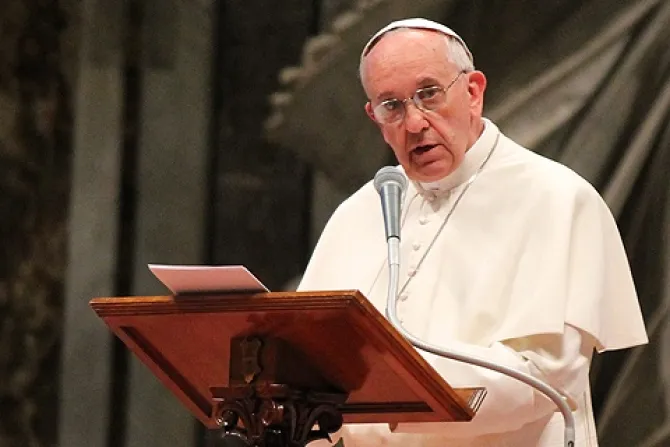Vatican City, Jul 6, 2013 / 07:28 am
The theme of light is pivotal in the first Church encyclical written by "four hands."
"Lumen Fidei," or "The Light of Faith," is the first encyclical issued by Pope Francis. Released July 5, it draws on work drafted by former Pope Benedict XVI before his resignation.
The document reveals the continuity between the previous Pope and the current one. Why is light so important for both Pontiffs?
Benedict XVI's pontificate was wholly aimed at showing that we cannot be content with the smaller lights of reason, and that we should reasonably reach for the bigger light of faith.
Pope Francis' pontificate is intended to carry that light of the faith to the peripheries of the world.
At a general audience on June 12, Pope Francis said that "if in a stadium – say the Olympic stadium in Rome or the San Lorenzo in Buenos Aires – on a dark night, if someone turns on a light, you can barely see it, but if the other 70,000 spectators turn on their own light, the whole stadium shines."
Turning on their own light means, in fact, re-turning to God. This was a main goal of Benedict XVI's pontificate.
One of the roots of this goal came in Joseph Ratzinger's 1994 visit to Specola Vaticana, the Vatican Observatory, which is an astronomical research and educational institution supported by the Holy See and held by Jesuits.
For centuries, Jesuit Fathers went up to the telescope in the observatory in Castel Gandolfo, and from that privileged point of view they looked at the sky, trying to catch a sense of the heavens.
Now, the Vatican Observatory in Castelgandolfo is a museum. Although its tools and instruments still work, the lights of Rome – and all of Europe – are so bright that it is practically impossible to observe the stars. As a result, a new observatory was built in Mount Graham, Arizona.
Joseph Ratzinger – who would become Benedict XVI – was so impressed by the Specola Vaticana that he spoke about it in his homily during the 1994 Christmas Eve Mass in Berchtesgaden.
In that homily, he compares the observation of the sky to the search for God, as a type of metaphor.
And he concludes that "the lights of men, the lights we produced, hide the light of sky. Our lights hide the stars of God. It is almost a metaphor: because of the too many things we created, we can barely recognize the traces of the Creation of God, and the Creation itself."
This is a crucial point in the first of Pope Francis' encyclicals, based on a sketch by Benedict XVI.
"There is an urgent need, then," Pope Francis writes in the document, "to see once again that faith is a light, for once the flame of faith dies out, all other lights begin to dim. The light of faith is unique, since it is capable of illu¬minating every aspect of human existence. A light this powerful cannot come from ourselves but from a more primordial source."
That source is Jesus Christ, because "since Christ has risen and draws us beyond death, faith is also a light coming from the future and opening before us vast horizons which guide us beyond our isolated selves towards the breadth of communion."
(Story continues below)
Taking over the former Pope's encyclical and his words, Pope Francis carried forward Benedict XVI's ambitious program of returning the Church to God.
How will this be done in a Church that suffers from the gangrene of careerism and is perhaps excessively deferential to the media? How will it be carried out without trivializing solemn occasions and liturgies?
Following the example of Saint Benedict in his cloister, Benedict XVI aimed at a new civilization, using his speeches as the building blocks of a cathedral, moving attention away from gestures and actions and focusing instead on a deeper thought and theology.
Now that the doctrinal cathedral has been built up, Pope Francis can show the light of faith to the world from the loggia of the cathedral.
In the June 12 general audience, Pope Francis said, "Let our lives together be the one light of Christ; together we will carry the light of the Gospel to the whole of reality."
This is Pope Francis' ambitious program that draws from that of Benedict: to proclaim the light of faith, and to let it illuminate the world.
The encyclical can be accessed in CNA's resource section, found here.



